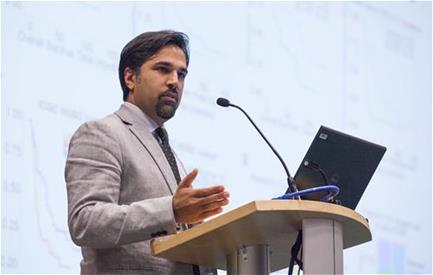

Doctors Sohrab Shah and Brad Nelson are two of the TFRI-funded researchers who participated in the study.
A new study led by a team of TFRI-funded researchers has uncovered the mechanisms used by deadly ovarian cancer cells to escape the immune system, setting the stage for a better understanding of how and why patients respond to promising new immunotherapies.
Immunotherapy stimulates the patient's own immune system to recognize and destroy tumour cells. It is yielding remarkable outcomes for cancer patients to date and is by far one of the most exciting and active areas of modern cancer care and research.
The study published in the scientific journal Cell used advanced molecular and computational techniques to analyze how tumour cells in patients with high-grade serous ovarian cancer (HGSC) — the most common and lethal subtype of epithelial ovarian cancers — escape attack from immune cells.
“Our findings reveal fundamentally new insights into the cause and consequences of ovarian cancer and immune cell interaction,” said Dr. Sohrab Shah, a senior scientist at BC Cancer, a UBC associate professor and senior author of the study. “The results provide a new lens through which we can interpret a host of recently launched ovarian cancer immunotherapy clinical trials around the world.”
The team of interdisciplinary researchers used advanced molecular measurements and computer algorithms to analyze how immune cells (aka, white blood cells) infiltrate tumours. They “zoomed in” to get a better look at the spaces between the immune and cancer cells to see the proteins present on their surfaces. And they sequenced DNA to understand genetic changes that took place within cancer cells after interacting with immune cells.
“Our findings reveal an evolutionary arms race between immune cells and HGSC cells,” said Allen Zhang, a UBC MD/PhD student at BC Cancer and the lead author on the study. “As the immune system mounts an attack on a tumour, some cancer cells are eliminated while others evolve and change to resist attack from immune cells. This may help us understand why HGSC often responds poorly to current immunotherapies.”
Killer T cells are a subtype of immune cell that have the powerful ability to target and destroy infected or cancerous cells. In this study, scientists noticed that a strong Killer T cell infiltration of ovarian tumours was associated with less diversity among the types of cancer cells present in the tumour. This indicated that Killer T cells had successfully tracked and eliminated many of the tumour cells as they evolved but they weren’t able to kill them all, prompting the scientists to take a closer look at the cells that managed to escape.
They identified combinations of genetic changes that help HGSC cells escape attack from Killer T cells and they plan to use this knowledge in the development of more powerful experimental immunotherapies, including T cell therapy, for gynecological cancers. T cell therapy involves extracting the patient’s own T cells, conditioning or engineering them to recognize and kill cancer cells and infusing large numbers of those programmed cells back into the patient’s body.
“We’ve known for several years that many ovarian cancer patients launch a strong immune response against their tumours, yet this response often fails to control tumour growth over the long-term,” said Dr. Brad Nelson, a distinguished scientist at BC Cancer and co-senior author of the study. “This study has revealed the different tricks used by HGSC tumours to escape from the immune system, leading to exciting new ideas for engineering more potent immune responses that can overcome these various escape mechanisms.”
Inspired by success in treating other cancers especially in most types of advanced leukemia, BC Cancer’s Immunotherapy Team, led by Drs. Brad Nelson and Rob Holt, is ready to launch the first of a series of clinical trials for ovarian and other gynecological cancers.
Study
Interfaces of malignant and immunologic clonal dynamics in ovarian cancer, is available
Authors
Allen W. Zhang, Andrew McPherson, Katy Milne, David R. Kroeger, Phineas T. Hamilton, Alex Miranda, Tyler Funnell, Nicole Little, Camila P.E. de Souza, Sonya Laan, Stacey LeDoux, Dawn R. Cochrane, Jamie L.P. Lim, Winnie Yang, Andrew Roth, Maia A. Smith, Julie Ho, Kane Tse, Thomas Zeng, Inna Shlafman, Michael R. Mayo, Richard Moore, Henrik Failmezger, Andreas Heindl, Yi Kan Wang, Ali Bashashati, Diljot S. Grewal, Scott D. Brown, Daniel Lai, Adrian N.C. Wan, Cydney B. Nielsen, Curtis Huebner, Basile Tessier-Cloutier, Michael S. Anglesio, Alexandre Bouchard-Coˆ te´ , Yinyin Yuan, Wyeth W. Wasserman, C. Blake Gilks, Anthony N. Karnezis, Samuel Aparicio, Jessica N. McAlpine, David G. Huntsman, Robert A. Holt, Brad H. Nelson, and Sohrab P. Shah.
Funding
This study is partially funded by a Terry Fox New Frontiers Program Project Grant in New Vistas on Cancer Biology and Treatment: Conceptual Advancements from the Forme Fruste Project and a Terry Fox Translational Project grant for The Immunotherapy Network (iTNT): Targeting Ovarian Cancer.